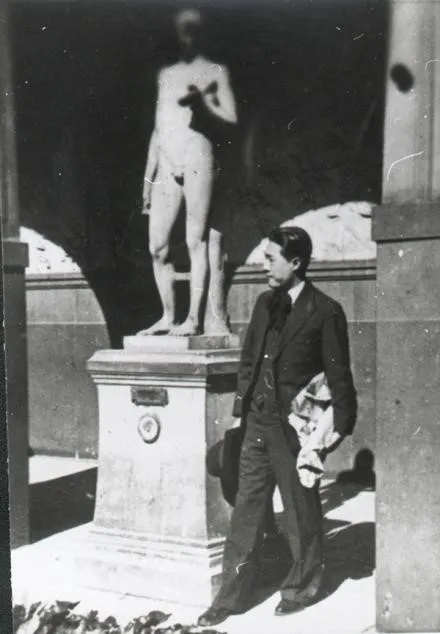1906年,一篇名為《清國人志於洋畫》的日文報道向世界宣告,一位名叫李哀的中國人考入了東京美術學校(今東京藝術大學),並且專為學習西洋繪畫而來。
李哀另一個更為人所熟知的名字是李叔同。
In 1906, a Japanese newspaper published an article about a Chinese young man named Li Ai who was admitted to the Tokyo Fine Arts School (now Tokyo University of the Arts) to learn western painting.
The young man was better known as Li Shutong (1880-1942), a pioneering artist who introduced western painting to China.
名為《清國人志於洋畫》的日文報道 An interview with Li Shutong was published on a Japanese newspaper.
同年入讀東京美術學校西洋畫科的還有曾延年。曾延年1911年3月在東京美術學校畢業,4月又入讀該校研究科,成為一名研究生。
Zeng Yannian (1873-1937), another Chinese student, was enrolled in the school in 1906 and in the same major as Li.
The two were the earliest Chinese graduates of the school. Zeng furthered his studies at the school after finishing the undergraduate programme while Li returned to China and incorporated western oil-painting techniques into domestic art education.
事實上,進入東京美術學校學習的中國留學生,最早的一位是黃輔周,於1905年(明治38年)進入西洋畫科,但因他中途退學,李叔同、曾延年便成為最早畢業於該校的中國留學生。李叔同則是最早將西方油畫學成歸國,並實施於本土美術教育的中國人。
However, the very first Chinese student who came to study at the school was Huang Fuzhou, who started in 1905 but soon dropped out.
確切地說,辛亥革命前,入學該校學習的“清國人”,應為10人,被有的論者稱為“清末十同學”。其中,除談誼孫專注於學習雕塑,其餘九人的專業皆為油畫。
Before the 1911 Revolution, or Xinhai Revolution that overthrew China's last imperial dynasty (the Qing Dynasty) and established the Republic of China, there were 10 Chinese students who had studied western arts in the Tokyo Fine Arts School. Among them, only Tan Yisun majored in sculpture while the others majored in oil painting.
李叔同畢業留影(中間者為李叔同)Li Shutong (central) was among a group of graduates of the Tokyo Fine Arts School.
近半個世紀裡,共有134名中國學子曾在這裡留學。學油畫的中國留學生共90人,佔中國留學生總數的68.2%;畢業生又為52人,佔57.7%。根據東京美術學校的慣例,凡是西洋畫科(1934年以後改稱油畫科)的畢業生,都要給母校留下一幅自畫像。
In nearly half of the 20th century, a total of 134 Chinese students had pursued study in the school, 52 of whom actually graduated. About 68% of the students majored in oil painting and by tradition, the graduates left a self portrait to the school.
自畫像,李叔同,1911年,日本東京藝術大學藏 A self portrait of Li Shutong painted in 1911, housed in the Tokyo Fine Arts School
20世紀初期東京美術學校西洋畫科專業教學情景 A photo shows students learning western painting in the Tokyo Fine Arts School, the early 20th century
幾乎同一時期,另一批中國留學生也在法國藝術院校/機構開始了求學之路。1911年,王如玖放棄軍事專業,轉學到巴黎國立高等美術學院和布林德爾雕塑工作室,學習油畫和雕塑;同年,吳法鼎終止學習法律,轉而前往巴黎國立高等美術學院學習油畫。
Besides Japan, Chinese youngsters also learned western arts in France in the early days. In 1911, Wu Fading, a law student, decided to quit and turned to study oil painting abroad in the École Nationale Supérieure des Beaux Arts (Fine Arts School) in France.
Likewise, Wang Rujiu left a military academy to learn oil painting at the same French school as Wu and later studied sculpture at the Burdell Sculpture Studio.
王如玖肖像畫 A portrait of Wang Rujiu
1915年,蔡元培在法國與吳稚暉、李石曾、吳玉章等共同創辦了“留法勤工儉學會”,倡導青年留學歐美,而林風眠,這位中國美術史上融合東西方風格的先驅,即屬第一批勤工儉學留法藝術生中的一員。
In 1915, prominent Chinese educator Cai Yuanpei (1868-1940) and his fellows, including Wu Zhihui, Li Shizeng and Wu Yuzhang, initiated the Diligent Work-Frugal Study Movement, a series of work-study programs which enabled Chinese students to work in factories as a way to pay for their studies abroad.
Lin Fengmian (1900-1991), a pioneering painter and art educator known for his blending of eastern and western art styles, was one of the first students benefiting from the movement.
《海邊》,林風眠 ,私人收藏 Boats by the Shore by Lin Fengmian, from a Norwegian private collection
1919年,北洋政府第一次專門劃撥一個公費留法名額給美術專業,獲得這個名額的就是徐悲鴻。換句話說,徐悲鴻是中國第一位公費留法藝術生。
In 1919, Xu Beihong became the first to win a state scholarship provided by the Beiyang government of the early Republic of China to study fine arts in France. He attended the École Nationale Supérieure des Beaux Arts between 1919 and 1927. Xu is considered the father of modern Chinese painting.
20世紀30年代,徐悲鴻重返母校並在桑園留影。In the 1930s, Xu Beihong went back to his alma mater in France and had a photo taken there.
除了以留學為目的,亦有畫家前往歐洲進行考察遊歷。1929年,劉海粟以教育部考察員之名赴歐洲各國進行藝術交流。這就使得他的歐洲之行在身份上完全不同於其他留法藝術家——不是作為學生,而是作為大師級訪問學者。
Besides art students, some professional Chinese painters also went on study tours to Europe at that time, such as Liu Haisu, who was known for helping modernize art education in China. In 1929, Liu was commissioned by the Ministry of Education and went to Europe for art exchanges.
劉海粟在1929-1931年間創作的大量油畫風景畫,具有明顯的印象派、後印象派、野獸派畫風。
From the works created by Liu between 1929 and 1931, one could tell that he was greatly influenced by the painting styles of impressionism, post-impressionism and fauvism.
劉海粟《帶噴泉的花園》,1930年,上海劉海粟美術館藏 A garden with Fountain by Liu Haisu, 1930, housed in the Liu Haisu Art Museum of Shanghai
一批又一批青年藝術家遠渡重洋,留學歐美、日本,回國後或發起美術社團,或創辦美術院校,或創立美術刊物,對中國的美術創作、美術教育乃至文化運動都產生了積極深遠的影響。
Over the years, batches of young Chinese artists who had studied abroad introduced western painting techniques to China and put them into practice. They established different art groups and schools in the country and founded periodicals of fine arts, which had a profound impact on China's art education and cultural industry.
中國留法學生合影,拍攝年份不詳 An old photo of a group of Chinese students in France


























